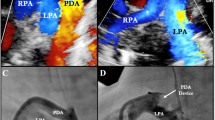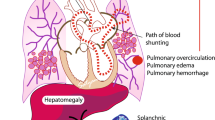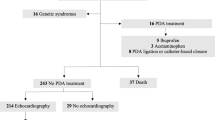Abstract
Objective
To compare the incidence of post-PDA ligation syndrome after surgical vs. percutaneous closure of PDAs in very low birth weight (VLBW) infants.
Study design
Cohort study comparing 59 infants who underwent surgical ligation with 25 infants who underwent percutaneous closure. Comparisons between groups were made using two-sample t-tests and a Fisher’s exact test. Comparisons of pre vs. post variables within each group were made using paired t-tests.
Results
Patients who underwent surgical ligation had a higher need for initiation of post-procedure hemodynamic support (12/59 vs. 0/24, p = 0.016), a higher post-procedure peak FiO2 (0.64 vs. 0.43, p = 0.004), and a larger absolute change in peak FiO2 (0.23 vs. 0.09, p = 0.008).
Conclusion
VLBW infants who had percutaneous closure of their PDA did not experience post ligation syndrome and had less escalation of respiratory support compared with infants who underwent surgical ligation.
This is a preview of subscription content, access via your institution
Access options
Subscribe to this journal
Receive 12 print issues and online access
$259.00 per year
only $21.58 per issue
Buy this article
- Purchase on Springer Link
- Instant access to full article PDF
Prices may be subject to local taxes which are calculated during checkout


Similar content being viewed by others
References
Chiruvolu A, Punjwani P, Ramaciotti C. Clinical and echocardiographic diagnosis of patent ductus arteriosus in premature neonates. Early Hum Dev. 2009;85:147–9.
Dollberg S, Lusky A, Reichman B. Patent ductus arteriosus, indomethacin and necrotizing enterocolitis in very low birth weight infants: a population-based study. J Pediatr Gastroenterol Nutr. 2005;40:184–8.
Evans N, Kluckow M. Early ductal shunting and intraventricular haemorrhage in ventilated preterm infants. Arch Dis Child Fetal Neonatal Ed. 1996;75:F183–F186.
Garland J, Buck R, Weinberg M. Pulmonary hemorrhage risk in infants with a clinically diagnosed patent ductus arteriosus: a retrospective cohort study. Pediatrics. 1994;94:719–72.
Cunha GS, Mezzacappa-Filho F, Ribeiro JD. Risk factors for bronchopulmonary dysplasia in very low birth weight newborns treated with mechanical ventilation in the first week of life. J Trop Pediatr. 2005;51:334–40. 10.1093
Benitz WE. Treatment of persistent patent ductus arteriosus in preterm infants: time to accept the null hypothesis? J Perinatol. 2010;30:241–52.
Benitz WE. Patent ductus arteriosus in preterm infants. Pediatrics. 2016;137:e20153730.
Noori S. Pros and cons of patent ductus arteriosus ligation: hemodynamic changes and other morbidities after patent ductus arteriosus ligation. Sem Perintaol. 2012;139–45.
Noori S, Friedlich P, Seri I, Wong P. Changes in myocardial function and hemodynamics after ligation of the ductus arteriosus in preterm infants. J Pediatr. 2007;150:597–602.
McNamara PJ, Stewart L, Shivananda SP, Stephens D, Sehgal A. Patent ductus arteriosus ligation is associated with impaired left ventricular systolic performance in premature infants weighing less than 1000 g. J Thorac Cardiovasc Surg. 2010;140:150–7. Erratum in: J Thorac Cardiovasc Surg. 2010;140:944
Noori S, McNamara P, Jain A, Lavoie PM, Wickremasinghe A, Merritt TA.PDA Ligation/Hypotension Trial Investigators et al. Catecholamine-resistant hypotension and myocardial performance following patent ductus arteriosus ligation. J Perinatol. 2015;35:123–7.
Noori S, Friedlich P, Seri I, et al. Patent ductus arteriosus in the preterm infant: to treat or not to treat? J Perinatol. 2010;30:S31–S37.
Ogando AR, Asensio IP, Sanchez de la blanca AR, Tejerizo FB, Luna MS, Jaurena JM, et al. Surgical ligation versus percutaneous closure of patent ductus arteriosus in very low-weight preterm infants: which are the real benefits of the percutaneous approach? Pediatr Cardiol. 2018;39:398–410.
Higgins S, Friedlich P, Seri I. Hydrocortisone for hypotension and vasopressor dependence in preterm neonates: a meta-analysis. J Perinatol. 2010;30:373–8.
Clyman RI, Wickremasinghe A, Merritt TA, Solomon T, McNamara P, Jain A, et al. Hypotension following patent ductus arteriosus ligation: the role of adrenal hormones. J Pediatr. 2014;164:1449–55.
Bourchier, Weston PJ. Randomised trial of dopamine compared with hydrocortisone for the treatment of hypotensive very low birth weight infants. Arch Dis Child. 1997;76:F174–F178.
Wang-Giuffre EW, Breinholt J. Novel use of the Medtronic micro vascular plug for PDA closure in preterm infants. Catheter Cardiovasc Int. 2017;89:1059–65.
Sathanandam S, Justino H, Warrer BR 3rd, Radtke W, Qureshi AM. Initial clinical experience with the Medtronic Micro Vascular Plug in transcatehter occlusion of PDAs in extremely premature infants. Catheter Cardiovasc Int. 2017;89:1051–8.
Pamukcu O, Tuncay A, Narin N, Baykan A, Korkmaz L, Argun M, et al. Patent ductus arteriosus closure in preterms less than 2 kg: surgery versus transcatheter. Int J Cardiol. 2018;250:110–5.
Zahn EM, Peck D, Phillips A, nevin P, Basaker K, Simmons C, et al. Transcatheter closure of patent ductus arteriosus in extremely premature newborns early results and midterm-follow up. J Am Coll Cardiol Intv. 2016;9:2429–37.
Acknowledgements
The authors would like to acknowledge George Eckert and the Department of Biostatistics at Indiana University for their assistance in statistical analysis.
Author information
Authors and Affiliations
Corresponding author
Ethics declarations
Conflict of interest
The authors declare that they have no conflict of interest.
Additional information
Publisher’s note Springer Nature remains neutral with regard to jurisdictional claims in published maps and institutional affiliations.
Supplementary information
Rights and permissions
About this article
Cite this article
Serrano, R.M., Madison, M., Lorant, D. et al. Comparison of ‘post-patent ductus arteriosus ligation syndrome’ in premature infants after surgical ligation vs. percutaneous closure. J Perinatol 40, 324–329 (2020). https://doi.org/10.1038/s41372-019-0513-8
Received:
Revised:
Accepted:
Published:
Issue Date:
DOI: https://doi.org/10.1038/s41372-019-0513-8
This article is cited by
-
Post-ligation cardiac syndrome after surgical versus transcatheter closure of patent ductus arteriosus in low body weight premature infants: a multicenter retrospective cohort study
European Journal of Pediatrics (2024)
-
Left ventricular function before and after percutaneous patent ductus arteriosus closure in preterm infants
Pediatric Research (2023)
-
Comparative Effectiveness of Surgical Ligation and Catheter Closure of Patent Ductus Arteriosus in Preterm Infants
Pediatric Cardiology (2023)
-
Phenotyping respiratory decompensation following definitive closure of the patent ductus arteriosus in preterm infants
Journal of Perinatology (2022)
-
Near-infrared spectroscopy for perioperative assessment and neonatal interventions
Pediatric Research (2021)



